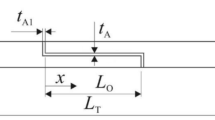Abstract
Most of adhesively bonded joints are under complicatedly distributed triaxial stress in the adhesive layer. For the estimating of the strength of adhesively bonded joints, it is crucial to clarify behavior of yield and failure of the adhesives layer under triaxial stress conditions. Two types of the adhesively bonded joints were used in this study: One is the scarf joint which is under considerably uniform normal and shear stresses in the adhesive layer, where their combination ratio can be varied with scarf angle. The other is the butt joint with thin wall tube in which considerably uniform pure shear can be realized in the adhesive layer under torsional load conditions. These joints can cover the stress triaxiality in adhesive layers of most joints in industrial application. The effect of stress triaxiality on the yield and fracture stresses in the adhesive layer were investigated using the joints bonded by three kinds of adhesives in heterogeneous and homogeneous systems. The results showed that both the yield and failure criterion depend on the stress triaxiality and that the fracture mechanism of the homogeneous adhesive is different from that of the heterogeneous one. From these experimental results, a method of estimating the yield and failure stresses was proposed in terms of a stress triaxiality parameter.
Similar content being viewed by others
References
N. E. Bekhet and D. C. Barton, J. of Mater. Sci. 29 (1994) 4953.
M. Kawagoe and M. Kitagawa, ibid. 23 (1988) 3927.
R. H. Sigley, A. S. Wronski and T. V. Parry, ibid. 26 (1991) 3985.
A. Silvestre, A. Raya, M. Fernandez-Fairen, A. Anglada and J. A. Planell, ibid. 25 (1990) 1050.
M. Imanaka and T. Iwata, J. of Adhesion 59 (1996) 111.
J. L. Lubkin, Trans. ASME, J. of Appl. Mech. 24 (1957) 255.
Y. Suzuki, Bulletin of JSME 27 (1984) 2372.
Idem., ibid. 28 (1985) 2575.
Idem., JSME Inter. J. 30 (1987) 1042.
R. D. Adams and W. C. Wake, “Structural Adhesive Joints in Engineering” (Elsevier Applied Science Publishers, 1986) p. 125.
R. G. Budynas, “Advanced Strength and Applied Stress Analysis” (McGraw-Hill, 1977) p. 362.
K. Nouno and T. Nagahiro, J. of Adhesion Soc. of Japan 22 (1993) 3 (in Japanese).
K. Hashimoto, “Epoxy Resins” (Nikkan-kogyo-shinn-bunnsha, 1978) p. 95 (in Japanese).
A. K. Kinloch, in “Structural Adhesives: Developments in Resins and Primers,” edited by A. K. Kinloch (Elsevier Applied Science, 1986) p. 127.
I. M. Ward and D. W. Hardle, “An Introduction to the Mechanical Properties of Solid Polymers” (John Wiley &Sons Ltd., 1993) p. 221.
W. J. Cantwell and A. C. Roulin-Moloney, in “Fractograph and Failure Mechanisms of Polymers and Composites,” edited by A. C. Roulin-Moloney (Elsevier Applied Science Publisher, 1988) p. 387.
A. Y. Yee, J. of Mat. Sci. 28 (1993) 6392.
ASM Handbook Committee, “Metals Handbook, Vol. 9: Fractograph and Atlas of Fractogtaphy,” 8th ed. (American Society for Metals, 1974) p. 91.
G. Dolev and O. Ishai, J. of Adhesion 12 (1981) 283.
Jean Lemaitre, “A Course on Damage Mechanics” (Springer Verlag, 1992) p. 44.
Author information
Authors and Affiliations
Rights and permissions
About this article
Cite this article
Imanaka, M., Fujinami, A. & Suzuki, Y. Fracture and yield behavior of adhesively bonded joints under triaxial stress conditions. Journal of Materials Science 35, 2481–2491 (2000). https://doi.org/10.1023/A:1004769719895
Issue Date:
DOI: https://doi.org/10.1023/A:1004769719895




